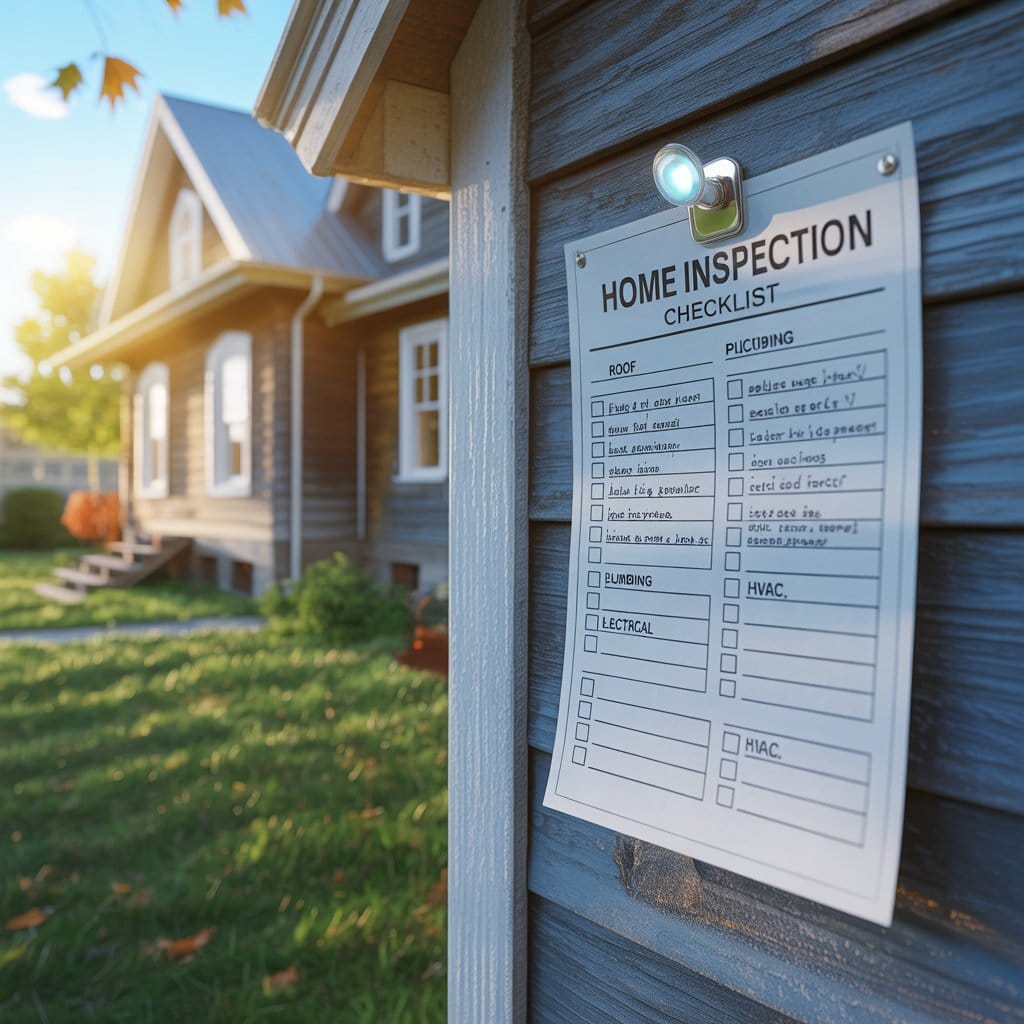Buying or selling a home is a significant milestone that involves many steps, and a home inspection is one of the most crucial. A thorough inspection can save you from future headaches by identifying potential issues before they become costly problems. Both buyers and sellers benefit from understanding the house inspection process, as it provides peace of mind and confidence in the transaction. Having a comprehensive home inspection checklist ensures no detail is overlooked during the evaluation.
From structural integrity to plumbing concerns, every aspect of the property needs attention. This guide will walk you through each step so that, whether you’re a buyer or seller, you’ll know exactly what to check before buying a house, an essential factor that can make or break a deal. Prepare yourself with this ultimate home inspection guide to navigate the real estate inspection checklist with ease.
Why a Home Inspection Matters for Buyers and Sellers
Home inspections are essential for a successful real estate transaction. They give buyers and sellers a clear view of the property’s condition.
For buyers, a home inspection can uncover hidden issues. It ensures they’re making a sound investment. Knowing potential problems helps in negotiating repairs or price reductions.
Sellers benefit by identifying necessary repairs ahead of listing. This proactive step can enhance the property’s marketability and justify the asking price.
Key reasons a home inspection matters include:
- Identifying safety hazards
- Revealing hidden defects
- Offering negotiation leverage
- Providing repair insight
Understanding these aspects helps both parties make informed decisions. It creates a smoother transaction experience for everyone involved.
Understanding the House Inspection Process
The house inspection process involves a detailed examination of the property. It assesses structural and functional integrity.
Typically, a licensed inspector visits the site. They examine both the interior and exterior. This comprehensive review forms the basis of the inspection report.
Inspectors use various tools and techniques. They check critical components like the roof, foundation, and major systems. Homeowners should prepare by making the property accessible and keeping documentation handy.
A typical house inspection includes:
- Exterior examination
- Roof and foundation check
- Interior room inspection
- Major system assessments
Understanding the house inspection process can help homeowners know what to expect. It eases any concerns about the property’s condition.
Essential Tools and Preparation for a Home Inspection
Proper preparation makes a home inspection smoother. Sellers should ensure all areas of the home are accessible. This includes basements, attics, and crawl spaces.
Inspectors come equipped with specialized tools. Tools like moisture meters, voltage detectors, and flashlights help identify hidden issues. Preparing these items ensures a thorough review.
A basic checklist for inspection day might include:
- Flashlight
- Ladder
- Moisture meter
- Voltage detector
Both sellers and buyers benefit from preparation. It ensures a comprehensive evaluation. Being well-prepared can help uncover all potential concerns.
The Complete Home Inspection Checklist: Room-by-Room Guide
A complete home inspection involves reviewing every room in the house. Each area contains elements that need evaluation. This guide provides a detailed room-by-room overview.
By systematically checking each room, nothing important is overlooked. This approach identifies both minor and major concerns. Buyers and sellers can prepare accordingly.
The checklist helps in understanding different components. From the exterior to interior spaces, thoroughness is key. This ensures any potential risks are caught early.
Exterior and Grounds
The exterior sets the stage for a home’s condition. Inspect pathways, driveways, and landscaping features. These elements can affect the property’s overall appeal and safety.
A well-maintained exterior can prevent issues like water intrusion. It also improves the home’s appearance and structural integrity. Focus on checking for cracks, rot, and drainage problems.
Key components to examine include:
- Siding and paint condition
- Walkways and driveway
- Fencing and gates
- Landscaping and grading

Check for foundation cracks near the exterior. Poor drainage could lead to long-term problems. Ensuring good ground conditions supports the overall home health.
Roof Condition Check
The roof protects against the weather and other elements. A thorough inspection involves looking for damage or missing shingles. Regular roof checks can prevent costly repairs.
Elements to inspect include:
- Shingles and flashing
- Gutters and downspouts
Check for sagging areas and leaks. These signs indicate potential roof failure. Early detection reduces the risk of extensive damage.
Foundation and Structural Integrity
The foundation is the backbone of your home. Signs of settling or cracking merit attention. Inspectors examine these for potential structural issues.
Critical elements to check include:
- Cracks in walls or floors
- Uneven floors
- Door and window alignment

Ensuring structural soundness is paramount. Addressing foundation issues early can save on expensive repairs. They also contribute to the home’s overall stability.
Garage and Outbuildings
Garages and outbuildings often need attention. These spaces must function safely and effectively. Inspection includes checking electrical systems and structural components.
Key aspects to review include:
- Doors and entry systems
- Electrical outlets
A safe, well-maintained garage increases the property’s value. Regular checks and maintenance are essential. This ensures safety and usability.
Interior Rooms and Living Spaces
Interior inspections encompass every room in the home. Different materials and uses necessitate distinct checks. This step secures a comfortable living environment.
Key items to include in the inspection are:
- Walls and ceilings for cracks or stains
- Windows and doors for functionality
Ensure all rooms have working electrical outlets. Look for water stains, which signal leaks. These factors influence your living comfort and safety.
Kitchen Inspection
Kitchens are hubs of activity. Focus on functionality and safety. Check plumbing, appliances, and electrical outlets.
Inspectors will check:
- Faucets and pipes for leaks
- Appliance wiring and grounding

Verify kitchen venting systems work correctly. A well-checked kitchen reduces hazards. It ensures efficiency and safety.
Bathroom Inspection
Bathrooms require careful inspection. Moisture issues are common here, needing special attention. Ensure fixtures work without leaks or drips.
Important aspects of a bathroom check include:
- Toilets and sinks for leaks
- Ventilation and mold checks
Proper ventilation prevents mold growth. Address small leaks promptly to avoid bigger plumbing issues. Bathrooms must remain dry and safe.
Attic, Basement, and Crawl Spaces
Attics, basements, and crawl spaces are critical. These areas reveal hidden issues. Check insulation, moisture levels, and pests.
Points to examine include:
- Insulation condition
- Signs of moisture or pests

Proper insulation maintains energy efficiency. Early pest detection prevents infestations. These spaces impact the home’s energy use and foundation.
Major Systems: What Inspectors Look For
Inspecting major systems is a vital part of the house inspection process. These systems ensure the home operates efficiently and safely. Inspectors check for potential issues that could affect daily living.
Understanding how these systems function can prevent unexpected failures. Early detection of problems saves money and hassle down the road. A comprehensive inspection includes electrical, plumbing, and HVAC systems.
Timely maintenance of these systems is crucial. It extends their lifespan and improves home safety. Knowing what to expect helps in planning for future repairs or upgrades.
Electrical System Check
Electrical systems need careful evaluation. Inspections ensure circuits can handle home demands safely. Faulty wiring poses serious risks, including fires.
Key elements reviewed include:
- Circuit breakers and fuse boxes
- Outlet functionality and grounding

Inspectors look for signs of wear and damage. Ensuring proper grounding prevents electrical faults. This step enhances the safety and reliability of the home’s electrical supply.
Plumbing Issues and Inspection
Plumbing systems require a thorough check-up. Leaks and outdated systems are common concerns. The focus is on preventing water damage and ensuring efficient flow.
Essential components to review include:
- Pipes for leaks and corrosion
- Water heater status

Identifying leaks quickly can avoid costly repairs. Good plumbing maintains water pressure and quality. Keeping these systems in top shape is essential for home comfort.
HVAC System Inspection
HVAC systems regulate home climate. Regular inspections ensure heating and cooling efficiency. Proper function is crucial for comfort and energy savings.
Inspect the following:
- Air filters for cleanliness
- Thermostat operation

Checking the HVAC system extends equipment life. Clean filters improve air quality. Efficient systems lower utility costs and enhance overall living conditions.
Water Damage Signs and Moisture Problems
Moisture issues can lead to serious damage. Inspectors search for indications of water damage throughout the home. Quick identification helps prevent long-term problems.
Be on the lookout for:
- Stains or discoloration on walls and ceilings
- Mold or musty odors
- Peeling paint or wallpaper

Addressing these signs early can avoid extensive repairs. Keeping moisture levels in check is key to preserving your home’s integrity. Proactive measures can safeguard against potential health risks and costly damages.
Pest Inspection: What to Watch For
Pest infestations can undermine your property’s value. Inspectors examine the property for signs of pest activity. Knowing what to look for is crucial.
Key indicators include:
- Droppings or nests
- Damaged wood or wiring
- Unusual sounds in walls

Spotting these issues helps in taking immediate action. Regular pest inspections keep your home safe and maintain its structural integrity. Proactive measures can prevent future infestations, ensuring peace of mind.
Safety, Code, and Compliance Checks
Ensuring your home meets safety standards is paramount. Inspectors verify if the property complies with local building codes. This assessment can identify potential hazards.
Key areas for compliance include:
- Fire safety measures
- Smoke and carbon monoxide detectors
- Adequate handrails and guardrails
Neglecting these checks can lead to costly penalties. Making sure your home is up to code safeguards against legal issues and enhances your property’s market value. Regular updates to safety features contribute to a secure living environment.
What to Check Before Buying a House: Key Takeaways for Buyers
Buying a house is a significant commitment. Knowing what to inspect can prevent unexpected expenses. Informed buyers can make smarter decisions.
Before purchasing, pay attention to these aspects:
- Condition of the roof and foundation
- Structural integrity of the home
- Functionality of major systems like HVAC and plumbing
Examining these elements helps you negotiate better terms. Always prioritize safety and functionality over minor cosmetic details. Comprehensive inspections guide you to a wise investment.
House Inspection Tips for Sellers: How to Prepare
Preparing for a home inspection can streamline the selling process. By being proactive, sellers can avoid last-minute surprises. Start by addressing any known issues.
Consider these preparation tips:
- Repair small damages like leaky faucets or broken tiles
- Ensure all utilities are functioning properly
- Clear clutter for easy access to areas
Being thorough in preparation can make your property more appealing. Show potential buyers the home’s true potential. Addressing concerns early can lead to smoother negotiations.
After the Inspection: Understanding Your Report and Next Steps
Receiving your home inspection report can feel overwhelming. Each detail helps you understand your property’s condition.
Focus on these three areas:
- Major issues needing immediate attention
- Minor repairs to consider
- Routine maintenance suggestions
Start by addressing major concerns first. Discuss any unclear points with your inspector. They can offer valuable insights.
Use this information to negotiate with buyers or make repairs. Ensuring the home is in its best shape benefits everyone involved.
Home Maintenance Checklist: Keeping Your Property in Top Shape
Regular maintenance is vital for preserving your home’s value. A proactive approach prevents small issues from becoming costly fixes.
Include these areas in your maintenance routine:
- Check and clean gutters
- Service HVAC systems annually
- Inspect the roof and attic for leaks
- Repaint and repair exterior surfaces
Consistent care extends the life of your property and enhances its appeal. Maintaining a checklist ensures no critical areas are overlooked.

Frequently Asked Questions About Home Inspections
Home buyers and sellers often have questions about the inspection process. Here are some common inquiries with brief explanations.
How long does a home inspection take? Typically, it takes 2 to 4 hours, depending on size and condition.
Expect insights on these topics:
- What inspectors check
- How to choose an inspector
- Typical costs involved
Understanding these aspects helps streamline the real estate transaction and ensures informed decisions.
Read Also: How to Wardrobe Planner with IKEA PAX
Conclusion: Making the Most of Your Home Inspection
A home inspection is a vital part of both buying and selling a property. It provides valuable insights into the home’s condition.
Understanding and acting on the inspection report can lead to smoother transactions. Ultimately, this process empowers both buyers and sellers, enhancing informed decision-making. Ensure that your investment is sound by using this comprehensive guide.
FAQs
1. What is included in a standard home inspection checklist?
A standard checklist covers structural integrity, roofing, plumbing, electrical systems, HVAC, and safety features. It ensures the home is safe and functional.
2. How long does a home inspection usually take?
Most home inspections take 2 to 4 hours, depending on the property size and condition. Larger homes or older properties may take longer.
3. What should buyers look for during a home inspection?
Buyers should check the roof, foundation, plumbing, electrical systems, and signs of water damage. Focus on major issues that affect safety and cost.
4. How much does a home inspection cost on average?
The average home inspection costs between $300 and $500. Prices vary based on location, size of the home, and additional services.
5. Do sellers need a home inspection before listing a house?
Yes, a pre-listing inspection helps sellers identify and fix issues early. This improves marketability and can lead to faster, smoother sales.



